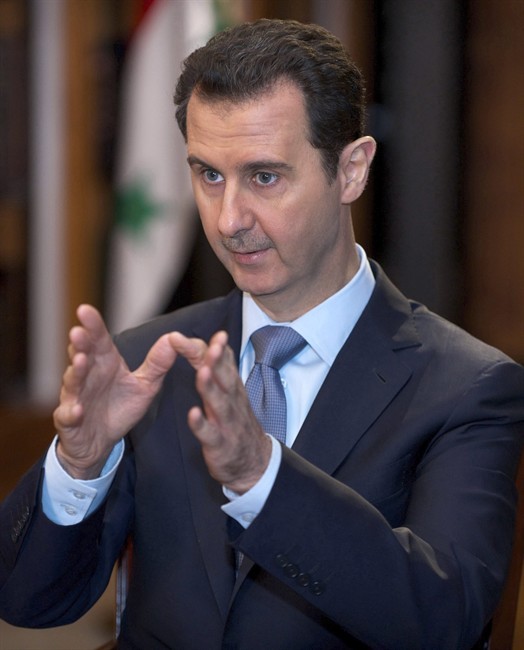The bodies of the young men in the photographs are emaciated, their bones protruding. Starvation was only one form of torture they endured. Some bear the marks of strangulation. Others have vivid bruises and welts from being beaten.

On Tuesday, the Security Council sees grim images of Syrian dead will meet privately to view projected slides of the dead, who offer mute testimony to the savagery of a Syrian civil war in which more than 150,000 have died.
France, which is hosting the closed-door meeting, says the photos to be displayed are part of a collection of 55,000 digital images of Syrians who were tortured and slain by Syrian President Bashar Assad’s regime. France says a majority of them were collected by a Syrian military police photographer code-named “Caesar,” who smuggled them out on flash drives when he defected.
Syria’s Justice Ministry has dismissed the photos and accompanying report as “politicized and lacking objectiveness and professionalism,” a “gathering of images of unidentified people, some of whom have turned out to be foreigners.” The ministry said some of the people were militants killed in battle and others were killed by militant groups.
READ MORE: Syrian rebels, gov’t blame each other for poison gas attack on village
Ten of the photos were publicly released in January in a study known as the “Caesar Report,” which was funded by the government of Qatar, a major backer of the opposition and one of the countries most deeply involved in the Syrian conflict. More will be seen Tuesday by the council.
- 2 teens charged with murder in case of 16-year-old killed outside Halifax mall
- Green Party deputy leader given jail sentence for Fairy Creek old growth protests
- Cars torched, explosions heard in suspected arson in Montreal neighbourhood
- Gas station clerk stabbed several times during violent attack at Ultramar in Montreal
The presentation at the Security Council is part of a process of documenting evidence of Syrian war crimes in the hope of eventually referring the perpetrators to the International Criminal Court in The Hague.
That is unlikely to happen anytime soon. Because Syria never accepted the jurisdiction of the ICC, the only way a case can be opened while Assad is in power is for the Security Council to order a referral.
Russia and China have used their veto power three times to block resolutions threatening sanctions on Syria. The hope is that Russia and China will eventually agree to an ICC referral if a resolution names both Syrian government officials and rebels as war crimes perpetrators, according to a Western diplomat, who spoke on condition of anonymity because no resolution is in the works.
U.N. human rights chief Navi Pillay has been pushing the council to refer Syria to the ICC for three years, but Security Council President U. Joy Ogwu said last week there is no consensus for such a step.
Still, France’s U.N. mission said in a statement that the meeting Tuesday “will also allow a discussion on the means to ensure accountability for these crimes.”
READ MORE: Syrian refugees hit million mark in Lebanon
Pillay said last week that abuses by both the Syrian government and rebels should be documented and brought to the international court. But she added, “you cannot compare the two. Clearly, the actions of the forces of the government … killings, cruelty, persons in detention, disappearances, far outweigh those by the opposition.”
Two of the authors of the “Caesar Report” will brief the council: David M. Crane, who was first chief prosecutor of the Special Court for Sierra Leone, and Dr. Stuart J. Hamilton, a forensic pathologist from Britain. The third author was Sir Geoffrey Nice, the lead prosecutor of former President Slobodan Milosevic before the International Criminal Tribunal for the former Yugoslavia.
“Caesar” had been a crime scene photographer for the Syrian military, the report says. When the civil war began, he and his colleagues were reassigned to photograph the tortured bodies of rebels and dissidents, providing proof to the regime that its enemies had been liquidated in detention. Victims were assigned a code number. Their relatives were told that the victims had died of “a heart attack or breathing problems” and their number was reassigned to a hospital. Bodies were then buried before relatives could view them.
A relative of “Caesar” who defected early in the civil war kept in contact with him, and persuaded “Caesar” to collect the images over the next three years, the report says. The report’s authors found “Caesar” to be credible when they debriefed him in January, they wrote. They said “he made it plain that he had never witnessed a single execution,” though he and his team had to photograph as many as 50 bodies a day.
In the collection of 55,000 images, each body was photographed four or five times, so the authors estimate that about 11,000 victims are pictured.
“Caesar” smuggled out almost 27,000 of the images, the report said. It said the others came from similar, unnamed sources.
The forensic team examined about 5,500 of the images and found that almost all were of men aged 20 to 40; only one woman was pictured, and she was clothed; and there were no children in the images.
The forensic team found that in a representative sample of images they studied, 62 per cent showed emaciation. Nineteen per cent showed neck injuries, and “16 per cent showed evidence of ligature marks on the neck.”
Based on the systematic pattern of injuries, the report said “there is clear evidence, capable of being believed by a tribunal of fact in a court of law, of systematic torture and killing of detained persons by the agents of the Syrian government” that would support “crimes against humanity” charges against the Assad regime.



Comments